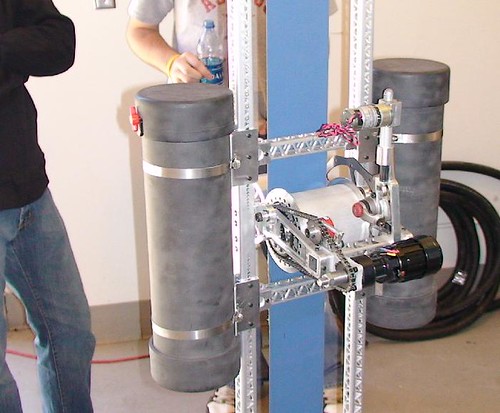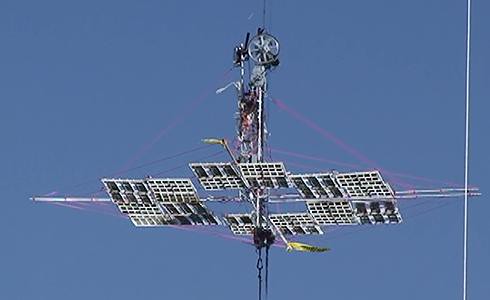The space elevator Games 2010 competition is being covered at the Space elevator blog The competition will be from October 19-21, 2007. The competition has some bad weather issues. There is a space elevator climber competition and a tether competition.
Five of the space elevator climber competitors are from Canada
UPDATE: More live coverage of the space elevator games at spaceelevator.com
All teams qualified based on indoor qualification runs yesterday.
Today outdoor on 100 foot track, Kansas City Space Pirates, Technology Tycoons and UBC-Snowstar and USST (University of Saskatchewan) have qualified. Team ETC, LaserMotive, McGill, and Centaurus did not advance past final qualification. Oct 19-21 (friday through Sunday) is the official competition.
Climbs are scheduled to take place every hour, on the hour from 11-6 Friday and 10-6 Saturday and Sunday. (weather-permitting) The four non-qualifying teams will also get a chance to climb the 400′ tether if slots are available. But preference will be given to the teams competing for Prize money. The Tether competitors are arriving and that competition also runs Friday through Sunday.

Kansas Pirates team set up reflectors to power their climber
Clayton Ruszowski, the president of the University of Saskatchewan Space Team (USST), said he and his Saskatoon-based team of 20 to 30 undergraduate engineering students have been working for about 10 months on a solar-cell skinned elevator prototype. USST won first place last year and was 2 seconds from meeting last years minimum requirement.
A share of the $500,000 space elevator climber prize will be given to teams that can climb the 100 meters in 2 meters/second. 50 seconds elapsed time or less. There are eight teams that expected to compete this year for the climber prize.
The Space Elevator is described at the Frequently asked questions part of the elevator2010.org site
-The Space Elevator is a thin ribbon, with a cross-section area roughly half that of a pencil, extending from a ship-borne anchor to a counterweight well beyond geo-synchronous orbit.
-The ribbon is kept taut due to the rotation of the earth (and that of the counterweight around the earth). At its bottom, it pulls up on the anchor with a force of about 20 tons.
-Electric vehicles, called climbers, ascend the ribbon using electricity generated by solar panels and a ground based booster light beam.
-In addition to lifting payloads from earth to orbit, the elevator can also release them directly into lunar-injection or earth-escape trajectories.
-The baseline system weighs about 1500 tons (including counterweight) and can carry up to 15 ton payloads, easily one per day.
-The ribbon is 62,000 miles long, about 3 feet wide, and is thinner than a sheet of paper. It is made out of a carbon nanotube composite material.
-The climbers travel at a steady 200 kilometers per hour (120 MPH), do not undergo accelerations and vibrations, can carry large and fragile payloads, and have no propellant stored onboard.
-Orbital debris are avoided by moving the anchor ship, and the ribbon itself is made resilient to local space debris damage.
-The elevator can be made larger by using itself to carry more ribbon pieces into place. There is no limit on how large a Space Elevator can be!
The rules for the 2007 climber/power beaming competition is here

Here is the crane that holds a tether to be climbed
The competition provides the race track, in the form of a vertically-suspended ribbon, and a power source in the form of an electrical outlet. Competing teams provide complete climbers system, which have to scale the ribbon while carrying some amount of payload, using only power that was transferred from the ground using beamed power.
The climbers net weight is limited to between 10 and 25 kg [22 – 55 lbs], and they must ascend the ribbon at a minimum of 2 m/s. [6.6 feet per second] Climbers will be rated according to their speed multiplied by the amount of payload they carried, and divided by their net weight. For example, a 15 kg climber, carrying 5 kgs of payload at 2.5 m/s will have a score of 5 · 2.5 · / 15 = 0.83
Power is unlimited. It is up to the competitors to build the most power dense machine that they can devise.
The 2007 prize purse, provided by NASA, is now $500,000.
The 2007 $500,000 award goes to the teams that can come up with the best Space Elevator ribbon sample, provided that they can beat last year’s winning ribbon by at least 50%. If an entry can meet the basic performance metric (~ 4 GPa-cc/g), then they will stand a very good chance to win the $500,000 purse.

USST, last years first place team, shows part of their climber
Other Canadians competing in the elevator contest include a group from the University of British Columbia and private groups from Toronto and Edmonton. There is also a team from Montreal (McGill University)

Kansas City Space Pirates and UBC-Snowstar are using reflected sunlight to power their climber. Kansas city’s climber has met the 1 m/s qualifying speed.

Brian Wang is a Futurist Thought Leader and a popular Science blogger with 1 million readers per month. His blog Nextbigfuture.com is ranked #1 Science News Blog. It covers many disruptive technology and trends including Space, Robotics, Artificial Intelligence, Medicine, Anti-aging Biotechnology, and Nanotechnology.
Known for identifying cutting edge technologies, he is currently a Co-Founder of a startup and fundraiser for high potential early-stage companies. He is the Head of Research for Allocations for deep technology investments and an Angel Investor at Space Angels.
A frequent speaker at corporations, he has been a TEDx speaker, a Singularity University speaker and guest at numerous interviews for radio and podcasts. He is open to public speaking and advising engagements.

